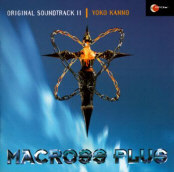Sound Decision
Take Two
by Trace Wilson,
Just as some anime begin to look dated, some music sounds like it was made in days gone by. I pulled out a couple of older, high-profile soundtracks to see if they still sound relevant when compared with today's. Sometimes you have to dust off the golden oldies to remind yourself of what you've got today, and the soundtracks and composers churning them out are becoming almost as high-profile as the anime themselves. (By this point, who hasn't heard of Yōko Kanno?) Fifteen years later, the Akira OST is still as timeless as ever, and even the second Macross Plus soundtrack can at least go a couple rounds with the latest synth-pop stuff out there.
Macross Plus Original Soundtrack #2 —Animetrax (2001-06-26)  Macross Plus OST II suffers from not having enough substance to carry it from end to end. After one album's worth of music was produced, a second must have been clamored for because here it is. The result is a fairly uninspiring mix of a couple decent tracks, a really great one and a whole lot of chaff in between. Macross Plus OST II suffers from not having enough substance to carry it from end to end. After one album's worth of music was produced, a second must have been clamored for because here it is. The result is a fairly uninspiring mix of a couple decent tracks, a really great one and a whole lot of chaff in between.Considering that story of Macross Plus heavily features an idol pop singer, you would expect to find lots of bubbly tunes on the soundtrack. The album starts off with the practically effervescent track, “Idol Talk,” one of the two Sharon Apple songs that appear on this disc. Vocals are provided by the always-capable Arai AKINO, this time singing in French, and the song bounces and swishes its way through five funky minutes. “Voices [Acoustic Version]” is a more sparse and solemn rendition of what was more musically populated on the first OST, featuring just a piano and the golden voice of AKINO. By removing a few instruments, Kanno manages to change the song from rather hopeful to hopeless, like an elegy to lost dreams. By far the standout cut on Macross Plus is the second Sharon Apple tune, “Pulse.” The song ebbs and flows, as the title would suggest, but the repetitive music is thoroughly overshadowed by the vocal performance and the mood set by it. Angelically sung by the otherwise unknown Wu Yun Ta Na, “Pulse” could be reason enough to buy this album if you've got a few extra bucks burning a hole in your pocket. “A Sai ën,” sung a cappella by the Raiché Coutev Sisters, is one of the better tracks on Macross Plus, even though it's very brief. The shift from counter-harmony to harmony halfway through the song is absolutely stunning. After this song, if you've been actively listening to the CD and not just playing it for background music, you'll probably change the CD. There's just nothing else to really get into and groove on. In light of how good the vocal tracks are on the Macross Plus soundtracks (see “SANTI-U” and “After, In the Dark” on the first OST), it's surprising that more of them weren't made. And why did the smoky, sexy Sharon Apple song, “The Borderline,” make its only appearance on The Cream P.U.F.? How can you bury one of the best and most memorable songs to appear in the anime on a dinky mini-EP? Overall, the Macross Plus OST II is a decent addition to your collection if you're a Yōko Kanno fan, but it's a hard recommendation otherwise. Aside from the breathtaking “Pulse,” the haunting “Voices” and the smooth ‘n’ sassy “Idol Talk,” the rest of the music is middling at best. The plinky video game feel of “Sweet Feather,” the yawn-inducing “Coma” and the dry and dusty “Welcome to Sparefish” provide nothing to hold anyone's interest. The music was meant to serve as a complement to the animation, but doesn't have the gumption to tell a story on its own. Grade: C+ |
Akira —Animetrax (2001-07-23)  Akira's soundtrack makes you sit up and take notice. Though the music performs its duty as background sound for the movie, there's just so much going on in the songs that you wind up stopping what you're doing to listen. It really grabs your attention and puts you into the surreal world that director Katsuhiro Ōtomo presents in the movie. By the way, don't listen to the Akira soundtrack if you're looking for your next favorite JPop song because it's not here. Akira's soundtrack makes you sit up and take notice. Though the music performs its duty as background sound for the movie, there's just so much going on in the songs that you wind up stopping what you're doing to listen. It really grabs your attention and puts you into the surreal world that director Katsuhiro Ōtomo presents in the movie. By the way, don't listen to the Akira soundtrack if you're looking for your next favorite JPop song because it's not here.Scored by Shōji Yamashiro and performed by his group, Geinoh Yamashirogumi, Akira flaunts and exorbitant sense of music structure and composition—it's as if the songs are penned via mathematical formula. The Yamashirogumi is a musical group that promotes the fusion of traditional instruments with new technology, and the result on Akira is incredible. Synthetic sounds blend with tribal drumming and chanting to form one of the most perfectly matched OSTs out there. Fortunately, there are copious liner notes accompanying the CD, detailing what instruments are used, how the track relates to the movie and what sort of mood Yamashiro was looking for. This is good because it's easy to get lost in some of the songs due to their lengths. However, unless you've got a decent knowledge of music terminology the notes aren't always helpful, like when Yamashiro says in his blurb for “Winds Over Neo-Tokyo,” “It starts off chromatically with tonal instability, but is actually constructed with pentatonic structure.” It's hard to take apart the soundtrack song-by-song because the whole is definitely greater than the sum of the parts. On their own, the songs more than likely won't make any sense to the listener, and may even be a bit boring. However, when you hear the percussive theme from “Kaneda” show up in “Battle Against Clown,” not only is it really cool, but helps to illustrate the action on the screen (since Kaneda was indeed fighting it out with the Clown gang). Despite that, there are some standout tracks here, and they deserve a bit of singling out. The first is Tetsuo's theme. At over 10 minutes, it does a great job mirroring Tetsuo's changing character during the course of the movie. Beginning with some percussion via the gamelan (an Indonesian instrument), “Tetsuo” slowly evolves into a hugely complex number through the addition of chanting, more drum lines and synthesizer. A chill quiet falls over the song just past the six-minute mark before reverting to the simple gamelan rhythm of the beginning that repeats to the end. In “Dolls' Polyphony,” Yamashiro makes full use of stereo imaging, with the repeated words “piron” and “poron” seeming to come from every direction. The base piron-ing fades out slightly to some more emphatic pirons, in advance of deep male chanting that takes over the song. It's totally creepy, in the same way a musicbox sounds creepy when added to a heavy metal song. Put your headphones on, fall asleep with this on repeat and see what kind of crazy dreams you have. “Shohmyoh,” which is based on Buddhist chanting, also gives me the tinglies, but in a good way this time. As the song progresses, the chanting builds in fervor, with the occasional chime added for punctuation. Synth percussion and guitar slowly begin to appear around the middle, just before a shift in mood around six minutes in. The chanting changes from religious to ritualistic and again builds in passion. The frenetic pace continues all the way to the end, before a heavy drum hit stops everything cold. With nearly 14:00 of music conforming to the structure used in the traditional Japanese theatre of “Noh,” “Illusion” is more or less a recreation of the Akira storyline as if it were a Noh play. There's a really cool old-school feel to the song, which is thrown off by a random angry chord at a couple different points. “Illusion,” performed live in studio according to the liner notes, absolutely highlights the Yamashirogumi creed of traditional meeting high tech. The last 30 seconds are pretty intense, as a growling synth is added to the Noh performance. Saving the best for last, “Requiem” does a fantastic job of recounting each of the preceding tracks, reliving them once again. There's a brief appearance of Kaneda's theme, followed by some almost hymnal chanting (replete with Latin lyrics that say, “Tetsuo, rest in peace”) and a bit of pipe organ. At eight and half minutes, a sort of Buddhist mantra blends seamlessly with the hymnal chanting, before being joined by the percussion and vocals found so much in the first few songs. It's more than 14 and a half dark, brooding and oppressive minutes that still manages to be a soft and gentle ending to a disc full of musical wizardry. Grade: A- |